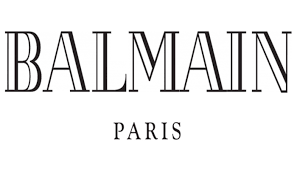
Balmain
Balmain is a French fashion house founded in 1945 by Pierre Balmain
Pierre Balmain (1914-1982) was born in Saint Jean de Maurienne, in Haute-Savoie. He was passionate about the tailor profession since he was a boy, but the reality of the small provincial town did not make it easy for him. So in 1934 he began working as an assistant at Molyneux, a very famous atelier which boasted an aristocratic and snobbish clientele: beautiful women, rich merchants, businessmen with expensive mania. In this context the young Balmain learned the perfection of the trade and strengthened the desire to surround himself with this beautiful world, with the habits of living rooms, with worldliness, luxury and wealth.

The beginning
A few years went by and in 1939 he became a friend of Christian Dior . After a short period of working side by side, the two decided to take their own path. So, in 1945, Balmain opened its headquarters in rue François I in Paris. The purchase involved many sacrifices, loans and pledges of the family jewels but Pierre believed in his ability and business from him. He started with a staff made of 20 workers, 50 models and his mother and his aunt at the quality control. Friends and people known in Savoy were the godmothers at his first fashion shows. Among these there were Gertrude Stein and Alice Toklas, whom the young tailor created very feminine suits for, so unusual for those women of culture but so important for the start of Pierre’s career.

The clothes began to circulate, also thanks to the help of Cecil Beaton and Christian Bérard, who introduced him to the world of theatre: the costumes that Balmain created for Giraudoux’s play La Folle de Chaillot are famous. From those first pieces for the small circle of nobles in Savoy, the garments reached the true European aristocracy. The first dress was made and sold to Princess Ghislaine de Polignac. Since then, many important people were added to his list of clients: the Duchess of Kent, the Duchess of Windsor, the Countess Charles Emmanuel de la Rochefoucauld, Queen Sirikit of Thailand, the richest bourgeois women and the most famous artists and divas of the time. His dress worn by Juliette Gréco, tight, sexy and total black, became the symbol of the existentialists. He also curated the dresses that Katharine Hepburn wore in the theater play The Slumdog Millionairess.
Balmain’s international fame
The American author Gertrude Stein, great friend of Balmain, defined the creations of the French couturier as the birth of the “French new style”. A new image of a woman, lively and immaculate at the same time, elegant but with a hint of lightheartedness We were witnessing the birth of “Jolie Madame”, symbol of perfection of the woman of the Fifties. All the divas had to own his creations: Brigitte Bardot , the anti-fashion diva par excellence, wore a Balmain when she met the queen in London.All the press talked about her dress, sexy but respectful of etiquette and classic elegance. The appreciation of the public made the designer win, in 1955, the Neiman Marcus Award, which legitimized him at the peak of success.
He was an extraordinary man: he loved worldliness and luxury, he never missed a premiere at La Scala, where he presented himself with a top hat and cloak, accompanied by his mannequins: the tall, charming and bewitching Irishman Bronwen Pugh, and his beloved Marys Therese and Praline; he organized parties and dinners with hundreds of guests and spoiled them with exotic culinary refinements that he imported from different parts of the world. With an extraordinary personality and strong charisma, Balmain has always impressed for his contrast of him, for the dualism that he expressed also in his creations of him: he was a lover of excessive and worldly life but perfectionist and scrupulous at work.

For Pierre Balmain, the Sixties were a period full of satisfaction. He could allow himself to experiment, use new fabrics and explore forms he never dared before, such as the pared-down which found favorable responses from the public and the international press of those years. With no middle ground, he mixed simple blue dresses and more eccentric evening outfits, he paired ermine blouses with checked skirts, combined lynx collars with tulle dresses, all according to his style, his clear and defined tastes. His love of him for tall women, for dancing and a comfortable life was also famous. This was in contrast to the rites and customs left to him from his origins, such as Father Bernardet’s blessing of all his new locations.

Everything seemed to be going fine. Celebrity, luck and earnings studded Pierre Balmain’s life until the first crisis. This one occurred following the death of his mother, a key figure in the couturier’s life. It was she, in fact, who took care of the business and of the economic management of the empire built in a few decades by Pierre.
The first wrong move by the inexperienced Balmain was to sell the safest source of income for the maison, the line of perfumes, including Vent Vert, to Revlon. There were numerous crises that, one after the other, affected the fashion house. One of them was just before the thirtieth anniversary of the creation of the maison. He sold everything to save it from collapse, from the residences of Croissy to that of Elba, even investing his own capital. But without positive results.
The crisis
The atelier worked, the requests were always numerous and the luxury ready to wear fashion line was fine. What was wrong was the organization: the brand was not on time in deliveries despite the fact that there were only two Parisian stores. The Industrial Development Institute (IDI) and some private banks that managed to relaunch the maison also intervened to support him.
From 1987 to 1995 the Swatch Group acquired the licenses of the Balmain maison watches, trying to maintain a high level of quality of the creations for the Parisian haute couture brand. To celebrate the tenth anniversary, in 1997, the company wanted to celebrate the French maison all over the world with a special collection called Elysées. They produced the flagship model, the one with the famous arabesques dial, whose inspiration derived directly from the pomp and opulence in the embroideries made by the great tailor on each garment.

Pierre, throughout his career, represented a certain idea of elegance for a specific type of clientele. Queens, princesses and stars of cinema and entertainment, without neglecting the importance of elegance in moments of everyday life. The birth of the ready-to-wear phenomenon was his merit. A solid cornerstone and source of income for most of the fashion houses that followed his example.
But it was 1975 and Giuliano Fratti received a sad and melancholic letter by his friend Pierre, in which the tailor described himself as “nothing more than an ancient rich man”. The atmosphere changed, the fate of the maison was increasingly negative, and Pierre Balmain no longer believed in his business: the press stopped writing about him and his collections. The only survivor of those years of splendor and fame was Jolie Madame, a nickname coined for his style that had given new life to women’s clothing in the first years after the war, bringing back the opulence and the glories denied during the difficult years of the conflict.
Pierre’s death
On the 29th of June 1982 Pierre died at the American hospital where some time earlier also another of the founders of French couture had died, Jacques Fath. Pierre had been very rich, but he left with nothing. Hubert de Givenchy read the farewell words at the church of Saint Pierre de Chaillot in Paris. The church was crowded with many fashion characters, but very few friends, surrounding the white coffin covered with white flowers. It was Paris ‘ last salute to one of its masters. When Balmain died, the Danish assistant and collaborator Erik Mortensen, who had worked for the brand for many years, decided to take over the maison. He managed the haute couture line confirming the tradition of the master’s creations, bringing flashes of novelty and freshness.
He was appreciated by the press and by professionals, Mortensen was awarded the Ditale d’Oro prize of French haute couture for the fall/winter 1983-84 collection and a second one a few years later, for the fall/winter 1987-88 collection. However, he left Balmain in 1990, to give way to the young Pierre Hervé, who led the fashion house until 1992. From 1993 until July 2002 Oscar de la Renta was at the head of the haute couture line of the maison. He made creations faithful to the Jolie Madame line, but with a renewed and modern design.
The changes of ownership
The death of the founder heavily influenced the ownership of the brand, which was immediately acquired by Canadian industrialist Erich Fayer and sold, in 1989, to Alain Chevalier, among the founders of LVMH; due to financial difficulties, the brand was resold in 1991 to Erich Fayer, who lead it until 1995, when he died. He was succeeded by the industrialist Alain Hivelin, who managed to revamp the company.
The beginning of the new century
Between 1998 and 2000 it was Gilles Dufour, Karl Lagerfeld‘s right-hand man for fifteen years, who managed the house’s numerous licenses and curated the ready-to-wear line. From March 2002 to the end of 2004, Laurent Mercier took over the artistic direction of the maison’s ready-to-wear line. From February 2006 to March 2011 Christophe Decarnin led the brand and took it back to the successes achieved by the couturier in the Fifties, also thanks to the advices of Emmanuelle Alt, fashion editor of Vogue Paris.

On 26th of April 2011, the new Creative Director of Balmain for women’s and men’s lines was appointed, following Decarnin’s decision to leave the maison due to personal problems. It was the French 25-year-old Olivier Rousteing, already present in the ranks of the Parisian fashion house, with a work experience at the Florentine maison Roberto Cavalli, for which he followed the men’s and women’s ready to wear lines.
Under his Creative Direction, Balmain had a new success and knew the younger public too, also thanks to the appreciation of international stars and a good use of social medias. This fact and the choice to develop also low cost collections (unforgettable the one with H&M in 2015, sold out during his first day of sale) revamped the fashion house and let it expand his public and increase his revenue.
In 2016, two years after the death of Alain Hivelin, President and main stockholder of Balmain (he had its 70 %), the maison needed big investments to continue its growth. So the property went to Mayhoola, the investment company of Qatar Royal Family which already owned Valentino and the majority of Pal Zileri.
Balmain releases first phygital Unicorn sneaker collection
Balmain has collaborated with Space Runners, a digital fashion community, to transform Unicorn sneakers into wearable virtual reality devices that can grant users unique abilities and connect Web2 and Web3. This is possible thanks to the collaboration between the brand, the american artist Ant Kai and the tech partner Space Runner.
The $1,200 shoe’s chunky sole, pointed toe, and aerodynamic, moulded silhouette were all intended to resemble something from the metaverse, as per creative director Olivier Rousteing’s brief.

The project results in a tangible, limited-edition sneaker, redesigned by Kai, packaged with an NFT variant of the item. The unique aspect lies in the fact that buyers can alter the digital collectible by adding various colors to it and minting it on Polygon, an environmentally conscious and sustainable blockchain network. The AI of Space Runner, which was trained using Kai’s “clouds” style, is crucial.
Balmain partnered with digital wearable and experience startup Space Runners to launch a new colorway of NFTs inspired by the Unicorn sneaker, which will be available alongside physical versions of the shoe. Customers have the option of paying with fiat money or ETH, and as of the time of publication, the final quantity and price were not yet known. A link to redeem their Unicorn NFT—a digital wearable with variable features and rarity—is sent to customers. This wearable can be used in the upcoming “fashion metaverse” game world of Space Runners.
This was not the first digital campaign for the Unicorn sneaker or for Balmain’s Space Runners collaboration. The tech company and the fashion brand collaborated earlier to create a Unicorn capsule collection that included both real and virtual shoes. They presented the collection at a hybrid fashion show that combined metaverse and augmented reality. The Over AR metaverse platform organized the event, which took place in Milan’s Piazza del Duomo.

The sneaker industry has never been afraid to embrace new technologies, being among the first to use AR, NFTs, and 3D printing. AI seems to be no different, especially in the context of virtual experiences. This sensibility seems appropriate for luxury brands in digital-physical contexts that appeal to younger, tech-savvy consumers without turning off more conventional customers.
Balmain expands on that to include the transaction and the entire shopping experience. In fact, both traditional fiat currency payment methods and cryptocurrency will be accepted for the limited-edition physical Kai sneaker bundle, which is only be available at Balmain’s new Atlanta flagship store and online.
You may also like:

